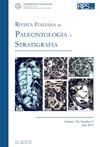罗马尼亚北dobrogea的上spathian至bithynian(下至中三叠世)腕足动物
IF 1.9
3区 地球科学
Q2 GEOLOGY
引用次数: 11
摘要
描述了在罗马尼亚北多布罗吉亚的几个三叠纪地区获得的腕足类动物。上斯帕西亚和爱琴海的哈尔施塔特型红色石灰石已在Desli Caira剖面取样,建议作为阿尼西亚基底的GSSP。Bithynian腕足类动物大多来自于Mahmudia采石场的Tubiphytes -微生物堆积,也来自Agighiol和Orta Bair的hallstatt型石灰石。他们的年龄估计是由从同一床采集的菊石支持的。上层Spathian和爱琴海组合Desli Caira由四个rhynchonellids,与一个属和两个物种新描述,Ortarhynchia petersi将军n sp. n和Austriellula iordanae sp. n。Bithynian组合构成最多样化的动物,有15种,四种新描述,Ortarhynchia petersi n . sp. n。将军Piarorhynchella kittli sp. n, Ptychomentzelia dobrogeana sp. n和p . simionescui sp. n。Mahmudia Tubiphytes相的,该组合在数量上主要为门缝虫和双缝虫,占整个组合的84.8%。Spiriferinids和rhynchonelliids是次要成分。相反,在Agighiol和Orta Bair的Hallstatt相中,rhynchonellis占优势。这里描述的组合很难与西特提斯的组合相比。比提尼亚的组合与土耳其次级层型描述的同类组合有很大不同。在北Dobrogea,碳酸盐底物和清澈、搅动的水支持了一个高度多样化的组合。相比之下,在Bithynia,腕足动物群落居住在更软、更泥泞的基质上,密度更高,多样性更低。Aghdarband(伊朗)地区也发现了Bithynian腕足类动物,形成了另一个不同的组合。在古特提斯古地理的框架下讨论了P/T危机后腕足动物的恢复和辐射,并与华南地区进行了比较。本文章由计算机程序翻译,如有差异,请以英文原文为准。
UPPER SPATHIAN TO BITHYNIAN (LOWER TO MIDDLE TRIASSIC) BRACHIOPODS FROM NORTH DOBROGEA (ROMANIA)
Brachiopods obtained from several Triassic localities in North Dobrogea, in Romania, are described. Upper Spathian and Aegean Hallstatt-type red limestones have been sampled in the Desli Caira section, proposed as the GSSP for the base of the Anisian. The Bithynian brachiopods mostly originate from the Tubiphytes -microbial buildup in the Mahmudia quarry, and also from the Hallstatt-type limestones of Agighiol and Orta Bair. Their age estimates are supported by ammonoids collected from the same beds. The upper Spathian and Aegean assemblages of Desli Caira consist of four rhynchonellids, with one genus and two species newly described, Ortarhynchia petersi gen. n. sp. n. and Austriellula iordanae sp. n. The Bithynian assemblages comprise the most diverse fauna, with 15 species, four species of which are newly described, Ortarhynchia petersi gen. n. sp. n., Piarorhynchella kittli sp. n., Ptychomentzelia dobrogeana sp. n. and P. simionescui sp. n. In the Tubiphytes facies of Mahmudia, the assemblage is numerically dominated by mentzeliids and dielasmatids, forming 84.8 % of the whole assemblage. Spiriferinids and rhynchonellids form the minor component. Instead, rhynchonellids prevail in the Hallstatt facies at Agighiol and Orta Bair. The assemblages described here are hardly comparable with those of the western Tethys. The Bithynian assemblage is very different from its equivalent described from the substage stratotype in Turkey. In North Dobrogea, the carbonate substrate and clear and agitated water supported an assemblage with high diversity. In contrast, in Bithynia, the brachiopod community dwelled on a softer and muddier substrate, with higher density and lower diversity. The locality of Aghdarband (Iran) also delivered Bithynian brachiopods, forming another different assemblage. The recovery and radiation of brachiopods after the P/T crisis is discussed in the framework of Palaeo-Tethyan palaeogeography, making comparisons with the South China localities.
求助全文
通过发布文献求助,成功后即可免费获取论文全文。
去求助
来源期刊
CiteScore
3.60
自引率
4.30%
发文量
28
审稿时长
>12 weeks
期刊介绍:
The Rivista Italiana di Paleontologia e Stratigrafia was founded in 1895. It publishes original papers dealing with all fields of paleontology and of stratigraphy, from Italy and the Mediterranean to the Tethys, as well across the globe from China to North America.

 求助内容:
求助内容: 应助结果提醒方式:
应助结果提醒方式:


